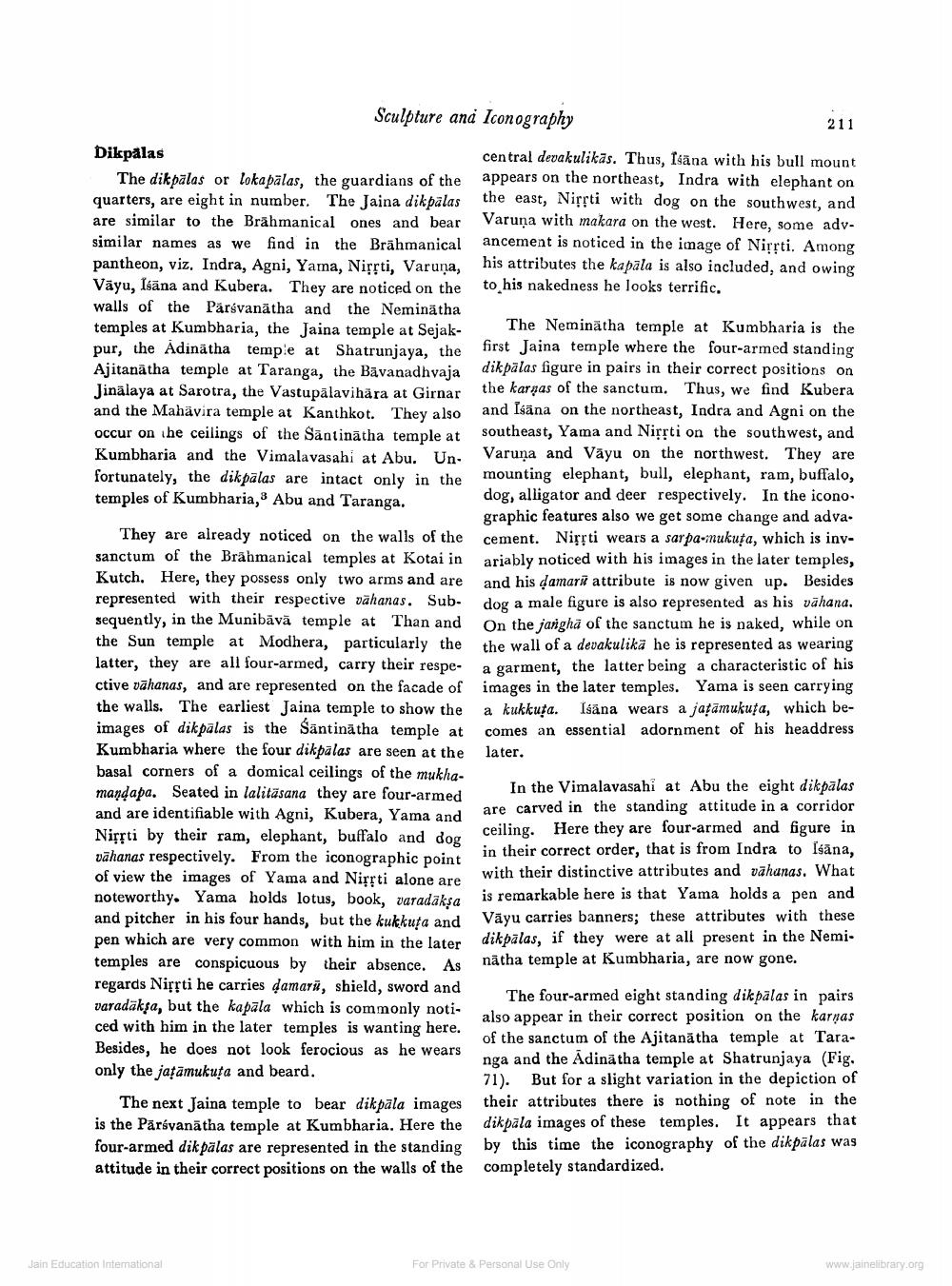________________
Sculpture and Iconography
211
Dikpalas
central devakulikās. Thus, Isäna with his bull mount The dikpalas or Loka palas, the guardians of the appears on the northeast, Indra with elephant on quarters, are eight in number. The Jaina dikpalas the east, Nirrti with dog on the southwest, and are similar to the Brähmanical ones and bear Varuņa with makara on the west. Here, some advsimilar names as we find in the Brahmanical ancement is noticed in the image of Nirrti. Among pantheon, viz. Indra, Agni, Yama, Nirrti, Varuna, his attributes the kapala is also included, and owing Väyu, Iśāna and Kubera. They are noticed on the to his nakedness he looks terrific. walls of the Pärsvanātha and the Neminätha temples at Kumbharia, the Jaina temple at Sejak
The Neminätha temple at Kumbharia is the pur, the Adinatha temple at Shatrunjaya, the first Jaina temple where the four-armed standing Ajitanatha temple at Taranga, the Bavanadhvaja
dikpalas figure in pairs in their correct positions on Jinalaya at Sarotra, the Vastupālavihära at Girnar the karpas of the sanctum. Thus, we find Kubera and the Mahavira temple at Kanthkot. They also and Isäna on the northeast, Indra and Agni on the occur on the ceilings of the Santinātha temple at
southeast, Yama and Nirrti on the southwest, and Kumbharia and the Vimalavasahi at Abu. Un.
Varuna and Vāyu on the northwest. They are fortunately, the dikpalas are intact only in the mounting elephant, bull, elephant, ram, buffalo, temples of Kumbharia, Abu and Taranga.
dog, alligator and deer respectively. In the icono.
graphic features also we get some change and adva. They are already noticed on the walls of the cement. Nirrti wears a sarpa-mukuta, which is invsanctum of the Brāhmanical temples at Kotai in ariably noticed with his images in the later temples, Kutch, Here, they possess only two arms and are and his damari attribute is now given up. Besides represented with their respective vähanas. Sub- dog a male figure is also represented as his vāhana. sequently, in the Munibāvä temple at Than and on the janghā of the sanctum he is naked, while on the Sun temple at Modhera, particularly the the wall of a devakulika he is represented as wearing latter, they are all four-armed, carry their respe- a garment, the latter being a characteristic of his ctive vāhanas, and are represented on the facade of images in the later temples. Yama is seen carrying the walls. The earliest Jaina temple to show the a kukkuta. Isäna wears a jatāmukufa, which beimages of dikpalas is the Säntinātha temple at comes an essential adornment of his headdress Kumbharia where the four dikpalas are seen at the later. basal corners of a domical ceilings of the mukhamandapa. Seated in lalitasana they are four-armed
In the Vimalavasahi at Abu the eight dikpalas and are identifiable with Agni, Kubera, Yama and
are carved in the standing attitude in a corridor Nirpti by their ram, elephant, buffalo and dog
ceiling. Here they are four-armed and figure in vāhanas respectively. From the iconographic point
in their correct order, that is from Indra to Isana, of view the images of Yama and Nirrti alone are
with their distinctive attributes and vahanas. What noteworthy. Yama holds lotus, book, varadaksa
is remarkable here is that Yama holds a pen and
is remarkabı and pitcher in his four hands, but the kukkuta and Väyu carries banners; these attributes with these pen which are very common with him in the later dikpalas, if they were at all present in the Nemi. temples are conspicuous by their absence. As nātha temple at Kumbharia, are now gone. regards Nippti he carries damarü, shield, sword and
The four-armed eight standing dikpālas in pairs varadaksa, but the kapāla which is commonly noticed with him in the later temples is wanting here.
also appear in their correct position on the karnas
of the sanctum of the Ajitanātha temple at TaraBesides, he does not look ferocious as he wears
nga and the Adinātha temple at Shatrunjaya (Fig. only the jațāmukuta and beard.
71). But for a slight variation in the depiction of The next Jaina temple to bear dikpala images their attributes there is nothing of note in the is the Parávanātha temple at Kumbharia. Here the dikpala images of these temples. It appears that four-armed dikpalas are represented in the standing by this time the iconography of the dikpalas was attitude in their correct positions on the walls of the completely standardized.
Jain Education International
For Private & Personal use only
www.jainelibrary.org




